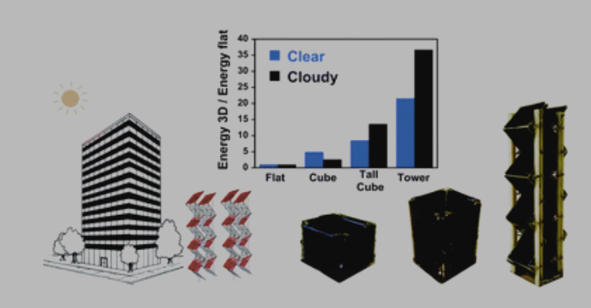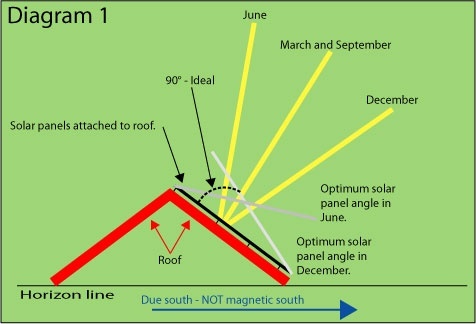- The earth intercepts 173000 terawatts of solar power (10,000 times the current human requirement).
- 1 year of exposure to the sun gives the earth twice the energy that's extractable from all the nonrenewable resources present on earth.
- Of all the solar energy incident on the earth's surface, 0.4-13% can be actually utilized due to land, weather, and absorption efficiency limitations.
- Solar energy utilization is rising by an average of 33% every year.
- It is expected that 27% of the world's total energy will be supplied by solar panels by the year 2050.
- The most efficient solar cell (yet) has an energy conversion efficiency of 46%.
- The average efficiency of commercially available solar cells is 20-25%.
Solar panels are rated at Standard Test Conditions (STC), this means solar panels are placed on a bed of light rated at 1000W/m2 at 25C and at sea level.
Often a rule of thumb is you will see up to 75% of the STC rating of the solar panel at midday in summer. i.e. 150W from a 200W solar panel.
- Active 3D solar panels (developed by MIT), arranged as mountain structures to maximize and optimize the area of interaction with light can achieve 20x the efficiency of conventional solar panels.
- Solar cells are being developed using graphene that can generate energy from rain (through ions), or are as thin as a soap bubble and/or can generate energy from artificial light too using a material called Perovskite (developed by Saule Technologies).
- The cost of solar cells is approximately $0.33 (or lower) per watt of power (without any installation charges).
- 0.1 square feet of solar cells are required to generate ~1 Watt of power.
- It is said that the cost of solar cells will half every 10 years (following Swanson's law).
- China predicts that it will be able to eventually decrease the cost of solar energy to $0.08 per kWh.
- Solar cells mostly need silicon which is the 2nd most abundant element on earth.
- Each solar cell generates a potential of 0.5V which can be scaled as per requirement.
- Solar panels can last for decades as there are no moving components other than electrons.
- As a consumer, you can expect to be billed ~8% more every year by your electricity providers due to rising energy costs.
In some rare cases you may see close to full output, i.e. the solar panel has been stored in a cool garage, and suddenly exposed to full midday summer sun. As the panel heats up, performance will drop to the more typical 75% output.
It is not typical to see the solar panel output in typical conditions, combined with the other losses (dirt on panel, cable/connection losses, sun orientation, panel temperature, solar controller losses, battery efficiency losses) the actual output that will be seen will likely be much lower.
- Solar panels operate efficiently at 25C (77F), so don't let the panels overheat. It can be said that with every 1C increase in temperature, the efficiency of the solar panels decreases by 1%
- To prevent the panels from overheating, use a heatsink or have/allow good airflow through the panels.
- Clean your solar panels whenever you can, dirty solar panels practically deliver 4%+ lesser power than clean solar panels.
- Calculate the total battery capacity required at home to be fully solar dependent.
- Experiment and find your peak power requirement to find the required discharge rate of your batteries.
- Lithium-ion may not be the best option for you for batteries depending on your budget and energy-power requirements per day.
- An inverter is required to convert DC power from the solar panels to AC power for home use.
- Know your actual peak sun hours. The world average is at least 9AM to 5PM (8hours).
- Accommodate for cloudy days without any sun hours and appropriately size your battery.
- Extra energy generated during peak hours can be sold to the government authorities at high prices and energy can be bought at night at cheaper prices to be stored in the batteries for later use.
- Mount solar panels at the latitude angle of your location wherever you live.
- It is logical energy efficient products and equipment to be able to depend on solar energy as much as possible. Example: 5 star Air conditioners.
- A billion people (13% of the world's population) live without access to a reliable energy grid, this is an application where solar (panel) farms can be deployed.
- MC4 solar connectors, these types of connectors are waterproof, affordable, high voltage rated, are pre-installed on most solar panels and are usually disconnectable. The current rating is typically limited to approx.
- The most practical wire for solar panels is PV1-F solar cable, this cable is most common in 4mm2 and 6mm2. A very rough rule of thumb is for arrays of less than 20A can use 4mm2, and 20A or larger should use 6mm2. If a larger size is required, it is recommended to run two runs from the array to the solar controller.
- The short-circuit current (ISC) is the current through the solar cell when the voltage across the solar cell is zero (when the solar cell is short circuited). When calculating the array current, use the short circuit current (Isc).
- The short-circuit current is due to the generation and collection of light-generated carriers. For an ideal solar cell at most moderate resistive loss mechanisms, the short-circuit current and the light-generated current are identical. Therefore, the short-circuit current is the largest current which may be drawn from the solar cell (at almost no voltage).
- Max power rating of a solar panel is where it produces the highest power current at maximum power voltage. Wattage of the solar panel is calculated by Max Power Voltage (Vmp) x Max Power Current (Imp)
When no power is being drawn from the solar panel, the Voc will be present. Most solar panels are approx. 23Voc.
- To charge a 12V battery bank, dependent on the charge controller, approximately 7V is required between the absorption voltage requirement of the battery and the solar panel Voc. I.e. a 12V battery that requires 14.8V absorption voltage, will need a panel with at least 21.8Voc.
Each solar panel will have one or more bypass diodes. Despite the marketing claims, the main purpose of bypass diodes is to protect the cells from overheating. When a cell is shaded it causes the cell to increase resistance, as current flows through the resistance, the cell heats up, and if the current is not bypassed around the cell, it will cause a hot spot and subsequent failure of the cell, and as each cell is wired in series, failure of the whole solar panel.
Never install a solar panel in a permanently shaded location, this can damage the bypass diode and cause hot spots. When a solar panel is completely shaded, it can become a resistance, causing the power flow of other solar panels to flow through it in reverse thus causing power loss in the system. Blocking diodes can be installed to prevent this. However, this event is rare, and the diodes will cause power loss at all times. Therefore, unless specifically required by the manufacturer, blocking diodes should be avoided. Most good quality solar controllers should have their own blocking diode installed, and therefore an additional blocking diode is not necessary for single panel installations. They are also not a replacement for string fusing.
- If a solar isolation switch is used, it should be sized to handle the full short circuit current of the array, plus ~20% to avoid nuisance tripping. I.e. if an array is rated to 30Asc, then the circuit breaker should be at least 36A, the closest match will be a 40A circuit breaker.
The solar charge controller or solar regulator must be sized appropriately for the array. A too small charge controller can be damaged, and too large can be unnecessary.
To size a controller, a simple calculation is: Power of Array in Watts / Battery Bank Voltage x 0.8 for losses, i.e. 400W / 12V x 0.8 = 26.7A controller required.
If using a PWM controller, typically you must use a larger controller than required. You must also use a 30-36 cell (17 to 20Vmp) solar panel on a 12V battery or 60-72 cell (34 to 40Vmp) solar panel on a 24V battery.
If using an MPPT controller, you can often size the controller smaller to reduce costs, while still allowing maximum performance in winter. You can often downsize a controller as it is often only in summer when the most power is available, that the controller will reach the maximum output, and therefore oversizing is not necessary.
MPPTs will have significantly improved performance when it is required the most, i.e. during the cooler months where there is more likely to be shading, and low light conditions.
When using an MPPT, ideally use a 36 cell or more (19Vmp+ limited by the maximum input voltage rating of the PV input of the solar controller) solar panel on a 12V battery.
When more than one solar panel is used, each solar panel can be connected to an individual solar charge controller, this will generally lead to the best performance but at the highest cost and complexity. An alternative is to wire the panels in either series or parallel or a combination of both.
Parallel arrays provide good tolerance to shade and keeps the voltage low, and thus safer. Panels can typically be wired in parallel when the same type of solar cell and voltage is used. If a P-type mono-PERC cell and n-type IBC cell are paralleled, differing coefficients of performance will cause a mismatch in voltages, causing the higher voltage panel to be “dragged down” to the lower voltage panel and increasing the risk of panel failure.
In a parallel solar panel array; If a solar panel were to fail by an internal fault, such as an internal bypass diode short circuit, the fault current of the array would all flow through the failed diode. There are many examples of this causing fires. String fusing has been designed to minimise the risk by disconnecting the failed solar panel from the array.
Fusing is not required when two or fewer solar panel are used because it is not possible for the fuse to reach the required tripping current.
Series solar panel array commonly used in 24V systems, one solar panel positive is connected to the next solar panel negative. In this case, the array current will remain the same as a single solar panel, however the array voltage will increase. Typically, 24V systems require an open circuit array voltage of at least 36.6V. Panels can only be wired in series when the cell type and current are the same, this is quite rare. Therefore typically only the same solar panel make and model can be wired in series.
The advantages of series wiring are:
- Reduced wiring cost
- Reduced power losses in cables
- Typically improved performance in MPPT solar charge controllers
The disadvantages are:
- Poor shade tolerance
- High voltage rated solar controllers often required
- Less safe
To ensure your solar panels are performing optimally, be sure to keep on top of this simple maintenance checklist.
- Clean on a regular basis with neutral soap & clean water, using a soft sponge or cloth;
- If in a marine environment, wash regularly with fresh water to avoid damage caused by saltwater;
- Periodically inspect the mechanical and electrical connections;
- Denatured alcohol (methylated spirit) can be used to remove grease etc.
Note:




